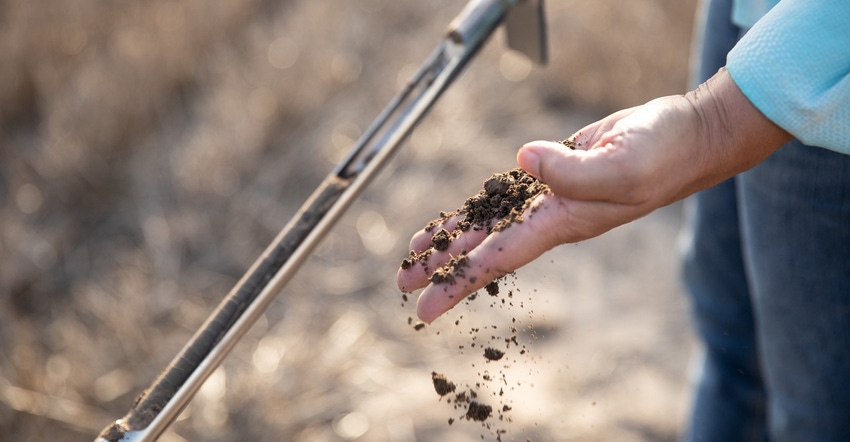September 13, 2021

On top of limiting the yield potential of crops, dry soils also have other important impacts which need to be considered when making nutrient management decisions for future years.
Here are five tips to keep in mind when taking soil samples and interpreting soil test results this fall to help make decisions for the 2022 growing season.
1. Pay attention to soil sampling depth. With dry soils, soil sampling depth can be an issue. As this video covers, a standard series soil test is calibrated for the top 6 inches of soil, so it isn’t a good idea to scrape off the soil surface or go deeper than 6 inches.
There are other measurements that call for a deeper sample, such as for nitrogen analysis, but for most purposes you want to stick to 6 inches. It also may be difficult to take the appropriate number of soil cores needed to get a good representative soil sample. Sticking to the appropriate sampling depth and number of cores per sample is important to get representative results.
2. Account for the nitrogen left in the soil so you don't overapply. Due to the dry conditions in Minnesota this year, it is a good idea to sample for residual nitrate this fall, especially in western Minnesota. In south-central and southeastern Minnesota, a spring preplant N test may be a better option.
Because it has been so dry during the growing season, much of the nitrogen fertilizer you applied may still be available for the next crop. Accounting for this N credit could help you cut N fertilizer costs for the 2022 growing season, which should be especially welcome given the current high cost of fertilizer. The main challenge with nitrate sampling is that the sample should be collected to a depth of 2 feet, which can be extremely challenging in dry years. Analysis of nitrate on shallower sampling depths is not suggested.
3. Consider phosphorus and potassium soil-test levels. The most relevant soil-test data from your soil tests are P and K test results. Lower-than-expected yields in dry years can leave unused fertilizer near the soil surface, which will be picked up by soil tests. Using P and K tests to adjust your rates accordingly can help you save on fertilizer costs for the following crop.
Remember, the K soil test can be impacted by dry soils, so lower-than-expected results may occur following drought conditions, especially if sampling after corn. With a potentially early harvest, it might be tempting to sample early — but it is best to sample around the same time as in previous years to help with the consistency of the test results. This is especially important for K. A substantial amount of K gets released into the soil as rain washes K out of crop stover. Allowing this process to take place will ensure that you account for that K in your test results.
Also, soils like to maintain nutrient equilibrium. After crops are no longer taking up nutrients and water, allowing some time for chemical and physical processes to occur will ensure your test results are more representative of what will be available for crop uptake the next growing season.
Testing the soil for zinc is also a good idea, but testing for other micronutrients is not recommended.
4. Keep an eye on soil pH. If your pH levels are less than 6.0, liming can help bring them within the acceptable range of 6.0 to 6.5 or more. Having the correct pH ensures greater availability of nutrients already in the soil, and it may mean you need to apply less fertilizer.
Dry soils can have a marginal effect on soil pH, resulting in values 0.1 to 0.3 units lower than if the soils are wet. Many crops can tolerate low pH values, but keep in mind that crops like alfalfa and some clovers will not do well when soil pH is lower than 6.5 — so knowing your crops’ tolerance to low pH is important since liming costs can add up.
5. Do not overreact if soil tests seem out of the ordinary. Dry years can present problems in situations where soil samples are collected in extended intervals, such as a four-year sampling cycle. If your soil test values seem too high or too low, you may want to consider sampling the field again sooner, and weigh soil sample results previously taken. Having multiple years of data is critical to interpret what the long-term trends in your field are.
Remember, you do not need to be exact in how much fertilizer is applied in a maintenance-based fertilization program, and underapplying fertilizer is not likely to cause yield loss unless soil tests are low. Simply put, there is a lot of flexibility when it comes to how much fertilizer to apply; in many circumstances, some is better than none.
Dry soil conditions can present challenges when collecting fall soil samples. However, careful planning can help you get the most out of your soil-test data. If taken correctly at the proper sampling depth, most soil tests should not be impacted by dry conditions. Knowing which tests can be impacted is critical when making plans for the upcoming growing season.
Kaiser and Fernandez are Extension nutrient management specialists with the University of Minnesota.
Source: Minnesota Crop News, University of Minnesota Extension, which is solely responsible for the information provided and is wholly owned by the source. Informa Business Media and all of its subsidiaries are not responsible for any of the content contained in this information asset.
You May Also Like




